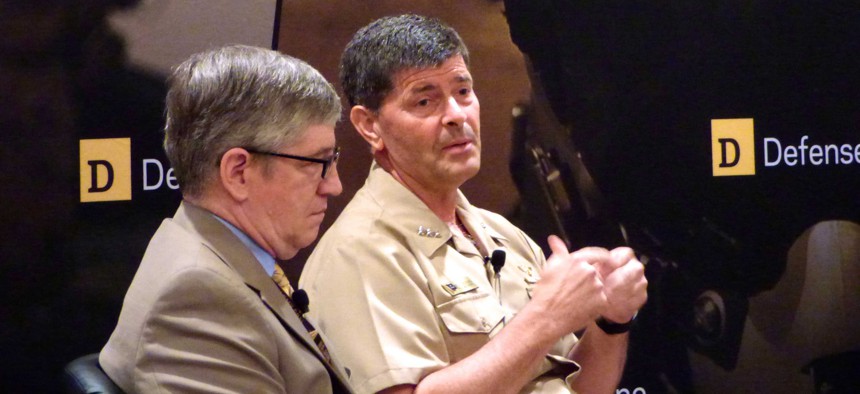
Deputy Chief of Naval Operations Vice Adm. Bill Moran and Deputy Army Chief of Staff Roy Wallace speak at Defense One's Force of the Future event on June 7, 2015. Marcus Weisgerber/Defense One
DoD's HR Overhaul: From Yugo to Maserati in a Year and a Half
Pentagon officials say they’re committed to overhauling the personnel system by the end of the Obama administration.
Working with 53 different pay and personnel systems, powered by 7 million lines of undocumented Cobol code, makes managing U.S. Army forces a rather large challenge, according to Roy Wallace.
“Right now, I’m driving a Yugo and what I need is a Maserati,” said Wallace, the Army’s assistant deputy chief of staff for personnel.
“I’d settle for a ’57 Chevy,” said Vice Adm. Bill Moran, the Chief of Naval Personnel.
Wallace and Moran spoke Tuesday at Defense One ’s Force of the Future event on recruitment, retention and readiness issues across the services. (Catch what happened in the video below.) Their zeal for an overhaul of the military’s personnel structure—or at least more flexibility in the system—was, if anything, exceeded by that of Brad Carson, acting undersecretary of Defense for personnel and readiness.
“There’s a desperate need for change,” said Carson. Especially in areas like cybersecurity, he said, the military’s rigid, up-or-out advancement system can’t keep pace with what he characterized as the “informationalization” of the modern world. The military, he argued, needs to move from a “rigid, time-based management system” to a “competency-based” one.
“We are satisfied with the gross inefficiency of not putting people in the right jobs,” and that needs to change, Carson said.
Whether the Pentagon can succeed in building a faster, sleeker personnel system where others have failed—and do it in the limited time left in the Obama administration—remains an open question. It may seem like a daunting challenge, Carson acknowledged, but only when viewed from a certain perspective. To prototype a new personnel system in three months, and fully deploy it in 18 months, “is not rapid by any other standard but government bureaucracy,” he said.
“There are some out there who would just love to wait us out,” Moran said. “I’m all in.”
Carson said Defense Secretary Ash Carter is committed to pushing innovative personnel policies in the remaining time left in the administration. At the very least, the up-or-out approach should be relaxed to allow the services to experiment with alternatives. That will “in no way hurt our warfighting capacity,” he said.
( Related : Navy Opens Fire on Cold-War Personnel System )
But even limited experimentation is made difficult by congressional restrictions on funding to upgrade Defense business operations, Wallace said. Lawmakers have sought to rein in the Pentagon’s spending on information technology systems, “but the second-order effects of that are killing us,” he said.
On the civilian side, Paige Hinkle-Bowles, deputy assistant secretary of Defense for civilian personnel policy, said officials are preparing for a phased rollout of a new performance management system starting next April. The department has been negotiating the details of the implementation with labor unions representing civilian workers. One goal is to better link individual performance plans to overall organizational missions.
Less than 10 percent of the Defense civilian workforce is under age 30, Hinkle-Bowles said. In a system traditionally geared toward encouraging military service members to transition into civilian jobs at the Pentagon, “there’s a lot of work to be done” in recruiting younger workers, she said.





